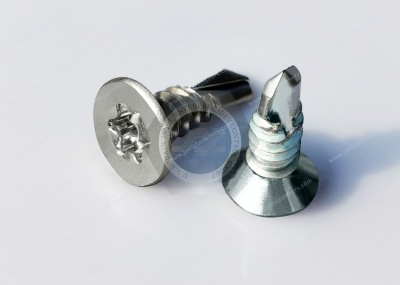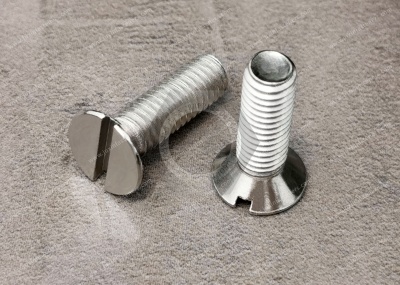Call Us
+86 136 6007 9809
Call Us
+86 136 6007 9809
Jul. 04, 2024
What is a slotted flat-head screw?
Two common types of flat-head screws
1. 82-degree flat head screws: This type of flat head screw has a head angle of about 82 degrees. Its head shape is similar to a cone and can be buried into the surface of the object to avoid the screw head being exposed to the surface of the object and to maintain the integrity of the surface of the object.
2. 90 degree flat head screws: The angle of the head of these flat head screws is about 90 degrees. The shape of its head is similar to a disk, which makes it easier to be inserted into the screw hole. This kind of flat-head screw is suitable for larger objects or occasions where more twisting force is needed.
1. Role of Slotted Flat Head Screws
Slotted Flat Head Screws are a type of fastener with a slotted design, which is usually used in applications that require strong sealing and self-locking. Slotted Flat Head Screws can be threaded to fit into a nut or seat to achieve tightening. At the same time, its countersunk head design can help the screw embedded inside the object to be fixed to avoid exposure to protect the appearance of the assembly.
18-8 Stainless Steel Slotted Flat Head Screws: These 18-8 stainless steel screws have good chemical resistance and may be mildly magnetic. All are passivated for added protection against oxidation and corrosion. They’re angled under the head to sit flush within countersunk holes. Length is measured from the top of the head.
Screws with an undercut profile have a shallow head for use in thin materials.
The most crucial feature of Slotted Flat Head Screws is their anti-loosening effect; the slots in Slotted Flat Head Screws increase the friction between the screw and the seat to achieve a self-locking impact, preventing the screw from loosening during transportation, vibration, or temperature change, etc. The Slotted Flat Head Screws are also available in a wide range of sizes and sizes.
Metric 18-8 Stainless Steel Slotted Flat Head Screws: These 18-8 stainless steel screws have good chemical resistance and may be mildly magnetic. All are passivated for added protection against oxidation and corrosion. They’re angled under the head to sit flush within countersunk holes. Length is measured from the top of the head.
Screws with a 100° countersink angle distribute pressure over a wide area to prevent crushing soft materials.
Metric Steel Slotted Flat Head Screws: Angled under the head, these metric screws fit in countersunk holes and sit flush with the surface of your part. Length is measured from the top of the head.
Screws with an extended tip, sometimes called an entire dog point, fit into a hole or slot to keep parts such as pulleys and gears aligned. Use these screws in place of dowel pins; their threads clamp your parts down and keep them from rotating.
Screws with a black-oxide finish have mild corrosion resistance, but only in dry environments. Zinc-plated screws have a layer of zinc that protects the steel from rust in wet environments and extends the life of the screw.
DIN 925 and ISO 2009 (formerly DIN 963) screws meet international standards for fastener dimensions. ISO 2009 and DIN 963 are functionally equivalent, with slight differences in head height, diameter, and thread length.
Metric Brass Slotted Flat Head Screws: Brass screws are electrically conductive, nonmagnetic, and have good corrosion resistance. They’re angled under the head to sit flush within countersunk holes. Length is measured from the top of the head.
316 Stainless Steel Slotted Flat Head Screws: More corrosion resistant than 18-8 stainless steel screws, these screws have excellent resistance to chemicals and salt water. They’re passivated for added protection against oxidation and corrosion and may be mildly magnetic. Screws are angled under the head to sit flush within countersunk holes. Length is measured from the top of the head.
Screws with an undercut profile have a shallow head for use in thin materials.
2. Usage of Slotted flat-head screws
The use of slotted flat-head screws requires the selection of appropriate screw specifications. Selection of screws needs to take into account the texture, thickness, shape, and other factors of the object to be fixed and select the matching size and length. At the same time, when aiming at the hole, care should be taken to start screwing the screw in the correct position to avoid deviations that may prevent the screw from being used properly.
Slotted flat-head screws are generally used on assemblies that require sealing and anti-loosening effects. When screwing in with the screw, it needs to be screwed into the hole gradually, and appropriate force should be applied to it. If it feels too tight or loose, you must stop or adjust the force in time. After correct installation, the screws can be kept fixed at all times by the self-locking and anti-loosening features.
3. Conclusion
The slotted flat-head screw is a standard fastener, and its unique design can help users realize a variety of functions, such as fastening, sealing, self-locking, and anti-loosening. Care must be taken to choose the correct specifications and install them using the appropriate strength and method. Through the proper use of Slotted Countersunk Head Screws, the safety and stability of the assembly can be ensured in long-term use.
If you need Metric 18-8 Stainless Steel Slotted Flat Head Screws and provide professional technical support, please get in touch with us at adelajonly@gmail.com or visit our website at https://www.juxinfasteners.com.


Contact Us
Tel.:
+86 020 8621 0320
+86 020 3121 6067
Technical Support:
Navigation
SEND INQUIREY